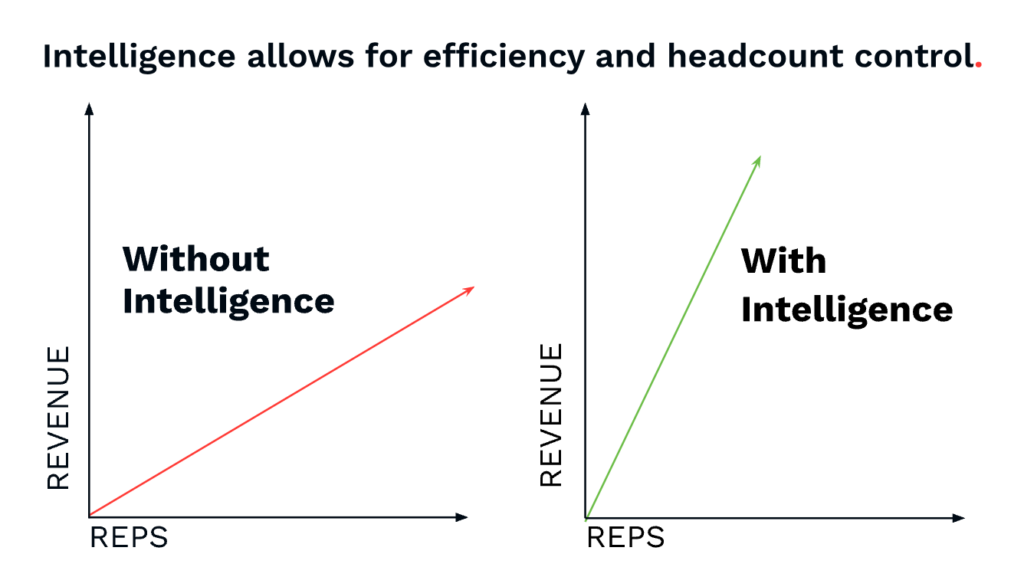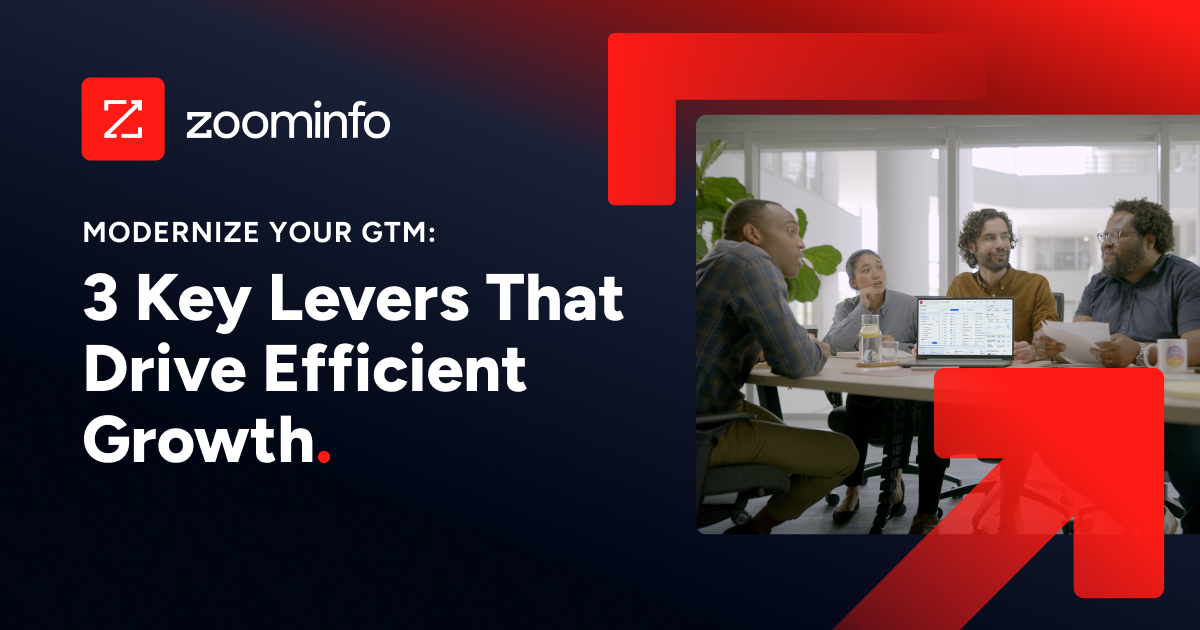Every company I talk to, big and small alike, is asking me the same thing lately: “How do we modernize the way we go to market?”
What they’re really asking is: How can we improve our sales efficiency? How can we replicate the work of our best salespeople and marketers across the entire business? How can we leverage data to work smarter?
Many companies have assembled a great tech stack, but they’re now faced with the hard work of changing behavior, driving use cases into the field, and actually changing the way they go to market. Driving an incredibly efficient go-to-market motion is more important than it has ever been — it’s become the North Star for how companies are evaluated by management and investors.
A modern go-to-market (GTM) strategy is powered by robust data and targets customers at scale through real-time, aligned, and automated sales and marketing outreach.

The graph on the left is the way most companies have historically driven more sales — simply by growing headcount. While this works, it’s the least efficient way to grow the top line. The graph to the right shows how that trajectory changes when you deploy a modern go-to-market organization that drives sales by leveraging data and insights.
Improving the efficiency of your GTM strategy doesn’t just drive growth. It also unlocks dollars that can be invested back into the product to drive innovation, which together creates this incredible flywheel of success.
I’m sure you’re thinking — yeah OK, sounds great, everybody wants to do that — but how do you actually accomplish it? At ZoomInfo, we know that it’s not only possible to run a modern GTM motion, but if you’re not doing it, you’re falling behind.
I’m going to walk you through three key levers you can pull to make this happen:
1. Unlock insights and increase quality leads
2. Convert more of those leads into customers — or at higher average sale prices (ASPs)
3. Close deals faster
GTM is the beating heart of every company. Success and failure don’t come in better finance reports, better legal structure, or better investors. They’re not even guaranteed by a better product. Without a modern GTM motion, a business just doesn’t exist.
Unlock Insights and Increase Quality Leads
First you need to generate more leads of the same or better quality – at the same cost or less — at the top of the funnel.
That starts with data and signals at the core of everything you do – quality insights that flag real-time opportunities and risks across your customer and prospect base.
For example, you need to know every time one of your champions leaves a company for a new job. Those moves create opportunities and risks for your company, and you need a system that makes sure you take action each time that happens. You also need to know when a prospect or client gets funding, adds a specific technology, hires a new CHRO or new CFO, brings on a new CRM, opens a new office location, does M&A — the list goes on and on.
You also need streaming intent data, which can tell you when companies are doing research about a specific topic on The New York Times or Business Insider, for example, and can alert you when they’re in the market for your solution.
The better you can target your ideal customer, the more you can increase quality leads.
Once you have that information, it should trigger an action for your team. It can be as simple as telling a sales rep to actually orchestrate an outbound campaign, or send an email, or make a call. That’s where engagement comes in.
Convert More of Those Leads Into Customers — or at Higher Average Sale Prices (ASPs)
So how can you increase your conversion rate and bring more customers on board? You have to engage with prospects and customers more effectively by aligning your sales and marketing teams in a single platform with one source of truth driving their outreach efforts.
Today, most sales and marketing teams aren’t using the same data or even the same success metrics. The lack of coordination between the two teams is one of the biggest challenges facing businesses today and makes them incredibly inefficient.
At ZoomInfo, we’ve developed a really strong level of alignment between sales and marketing. We did this through:
Developing targets together. Sales and marketing work very closely to develop our targets throughout the funnel each quarter and then revise them on a monthly basis. They set yearly and quarterly plans on who our ICP is by product line, and leverage our ZoomInfo and CRM data to build really robust datasets to target across channels.
Weekly CMO/CRO meetings. Our sales and marketing leaders have weekly performance reviews where they discuss what’s going well and what’s not, and their teams also have weekly detailed reviews.
Shared ownership of sales development rep (SDR) success. Our SDRs sit in sales, but marketing is responsible for scaling their outreach.
Finally, we’ve increased the velocity of our go-to-market motion by running plays. (Spoiler alert: We open-sourced our plays for free on our website if you want to copy our playbook.)
Close Deals Faster
Imagine what life would be like if you never missed a key selling opportunity again. That’s the world you can unlock when you run GTM plays.
When a specific thing happens in-market — we call these signals — it automatically sets off a chain reaction that powers your workflows, so you’re able to immediately take action.
Every play starts with a signal that is generated by data. Think of signals as actions taken by contacts at your target accounts. It could be a CFO visited your pricing page, or researched a solution like yours online. It could be a company hiring a new CIO or moving their headquarters to a new location.
Let’s go back to the example I gave earlier: A champion at one of your key customers gets a new job at a different company. This creates a great opportunity for you to follow up with them.
Imagine if you could be notified the moment this happens, and set up an automated email congratulating this person? That kicks off a new deal without any effort on your part — it all happens automatically. Think about the time and effort saved across the entire company if you had all of your sellers running this play.
Once you’ve started running plays, you need automated technology that helps you run them at scale across your organization.
The data shows this strategy works. Bain & Co. found that companies that implement go-to-market plays and run them effectively are three times more likely to outperform their competitors.
Compare this to any other “surefire” organizational tactic — the companies that become go-to-market play experts beat everyone else by a mile.
You need to make data work for you, for your company, for your product. Your competitors ARE doing this, and these are the results that they’re going to see. If you’re not doing this, you’ve already lost.
Modern GTM: a Strategic Advantage
Tackling optimizations and improvements across these three levers and doing it with software, data, and insights is how you modernize your go-to-market strategy.
At ZoomInfo, we’ve done 11 acquisitions in our history. In our biggest, most transformational M&A, we found companies with great products and really poor go-to-market efficiency. It’s when I learned, for the first time, that an efficient go-to-market motion is not just a tactical or operational advantage, it’s actually an overarching strategic advantage.
Our GTM motion put us in a position to drive these really strategic and transformational acquisitions. Each of us, through this go-to-market modernization effort, have the ability to unlock a tremendous amount of strategic opportunity for our businesses.


